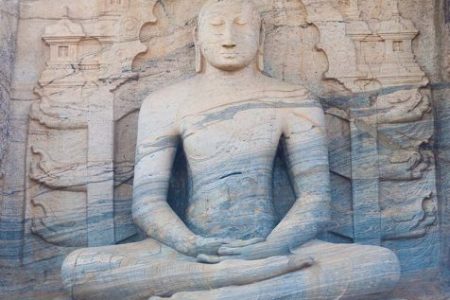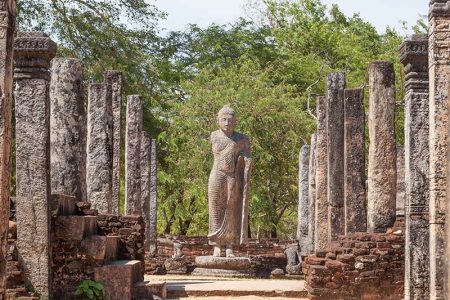For a glimpse of medieval Sri Lankan architecture and craftsmanship, there is no better example than Polonnaruwa Ancient City. Towards the end of the first millennia, due to the decline of Anuradhapura, as a result of invading Chola armies from South India, led to the shifting of the capital to Polonnaruwa Ancient City. From here, great Kings ruled the central plains and built magnificent palaces, monasteries and stupas.
Royal Palace of King Parakramabahu
The Palace of King Parakramabahu, easily the most prolific and gifted builder of the era, demonstrates ingenious design and construction for the time. The palace was seven stories tall and massive walls supported the structure. Additionally, an intricate drainage system was located under the palace walls. Kumara Pokuna, a bathing pool reserved for the use of Royals, can be seen nearby. Finally, the Royal Audience Hall, is located between these two structures. The audience hall is located on a foundation of elephant carvings. The entrance to the audience hall is guarded by lions, that are sculpted in solid rock.
Rock Sculptures at Gal Vihara
Perhaps the most popular site within the Polonnaruwa ancient city and a must see place is the Gal Vihara. A magnificent example of skilled craftsmanship, here lie four images of the Buddha, carved into solid rock. The first image, is the impressive 23-foot standing Buddha, followed by a 46-foot reclining Buddha. The third image is of a standing figure with the pose and expression depicting supreme compassion. Finally, the fourth image is a seated Buddha, framed within an ornate arch.
Places of Interest at Polonnaruwa Ancient City
The Vatadage, which lies within the Sacred Quadrangle, is an elevated circular relic house accessible from four sides and up a flight of steps which feature a statue of the Buddha in front of each flight. The Vatadage is apart of the Dalada Maluva, a special area of the Polonnaruwa ancient city that also includes Atadage and Hetadage. While the Thuparama, is a well preserved example of a gedige or vaulted shrine, which once held three statues of the Buddha. The Lankatilaka Shrine, is another excellent example of a vaulted shrine and contains a 17-foot statue of the Buddha within its high walls. Also, the Rankot Vehera and Kiri Vehera are two impressive stupas which should be visited when in Polonnaruwa.
King Nissankamulla also embarked on a very large building scheme. King Nissankamalla was not a local ruler, he was from Kalinga, in modern-day Orissa in Eastern India. Among the monuments he created were the Nissanka Latha Mandapaya, Nissankamalla Palace & Gal Potha.
The Sea of Parakrama
The ancient city of Polonnaruwa lies on the shores of the Parakrama Sumudraya, or Sea of Parakrama. A colossal man-made lake and bears a testament to the engineering prowess of the time. Furthermore, the lake was built to feed the thousands of acres of rice paddies that surrounded the region. King Parakramabanu was the builder of the lake and its named after him. A statue of the great King is located on the southern side of the lake.
Written by Jonathan Roelofsz for Travel Lanka Compass
















0 Comment